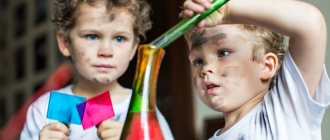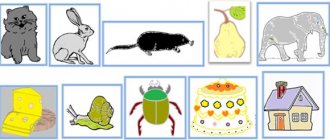What should mom do?
By “infecting” the baby with positive emotions, the mother stimulates his interest in the outside world, and since the satisfaction of this interest involves the expenditure of physiological resources, she stimulates in a certain direction both metabolic processes and tissue differentiation in the body of her baby. On the contrary, by transmitting negative emotions to the baby, we suppress not only his interest in the outside world, but also certain biological processes of his body. It is no better when the adults around the child “infect” him with too strong affective emotions.
These energy-intensive emotions deplete the child’s nervous system and can lead to somatic diseases. An adult’s mechanical fulfillment of routine tasks, his indifferent, indifferent attitude towards a small child excludes the possibility of any kind of emotional contact at all. With such an adult, the child does not have the need to communicate, and therefore does not develop cognitive experience and does not form the necessary communicative-cognitive means. There is a threat of delayed mental development and disruption of the child’s further interaction with adults. The child’s brain develops incorrectly or is delayed in the absence or deficiency of external stimuli.
And, vice versa: interest in an adult, curiosity about the outside world and communicative-cognitive activity are caused and supported, as we have seen, by positive emotions emanating from an adult. Therefore, we can repeat once again that for infancy, the emotional communication of a child with an adult is not a luxury, but a primary necessity, a condition for the formation of his psyche according to the human social type. Depriving an infant of the emotional attention of an adult at this early age leads primarily to abnormal development of the child’s personality.
If parents notice trouble, and this is not one symptom, but several (lack of babbling, humming, change in voice, behavior), then you should contact a specialist. And then, along with speech therapy correction (massage, articulation gymnastics, stimulation of vocal reactions), drug treatment, physiotherapy, etc. are prescribed.
About organizing classes
The development of a child’s speech occurs at every moment of his life. Everyday situations, including getting ready for bed, washing, eating, take place under almost the same conditions. This helps enrich children's vocabulary and strengthen their speech skills. Contacting children for various reasons creates their need for communication. At the same time, it is necessary to more actively use play and everyday situations that are pleasant for the child. For example, when washing or bathing a child, you can hum a composed song as you go, drawing the baby’s attention to the parts of the body and face about which it is sung, with a gentle touch:
- Where, where, where, where, where are our hands? (2 times)
- Here they are, here they are, here are our hands. (2 times)
- Where, where, where, where, where are our legs? (2 times)
- Here they are, here they are, here are our legs. (2 times)
- Where, where, where, where, where is our tummy? (2 times)
- Here it is, here it is, here is our tummy. (2 times)
- Where, where, where, where, where are our eyes? (2 times)
- Here they are, here they are, here are our eyes. (2 times)
- Where, where, where, where, where are our cheeks? (2 times)
- Here they are, here they are, here are our cheeks. (2 times)
The mother's affectionate voice and pleasant stroking movements will stimulate the child's independent vocal reactions.
Just communicating with your baby in everyday life is not enough for his development. It is necessary to use speech in objective and play activities. It is also advisable to conduct specially organized classes (games and activities). It is important to consider that at an early age, all tasks given to the child should be offered as an entertaining and interesting game. Only against a positive emotional background will the baby himself want to say a new word, repeat a combination of sounds or a phrase he heard.
When learning new words, you should always use a toy or object first and then a picture. If the child easily recognizes and names familiar objects and toys, you should gradually move on to working with subject and plot pictures.
Speech therapist, neurodefectologist Elena Gennadievna Timoschenko, author of the Territory of Health series of lectures “Early development of speech and intelligence of a child.”
How to stimulate speech development
The sooner trouble is noticed in the development of a child’s speech and the sooner specialists begin working with him, the better the results achieved will be: the reserve capabilities of the brain are especially high at an early age, during the period when speech is actively developing.
At the stage of pre-speech development (1-3 months), it is necessary to stimulate motor and communicative functions, develop and consolidate the child’s need to communicate with adults, strengthen the ability to fix gaze and follow a moving object. Gradually move on to active stimulation of fine motor skills. If there is no humming or impaired vocal reactions at this stage, the doctor may prescribe, along with drug therapy, speech therapy correction (facial massage, breathing and articulation exercises). At the 3rd stage of pre-speech development (3-6 months), the baby manipulates toys, pulls them into his mouth, rolls over and crawls towards an object that interests him, throws toys and follows their movement. In cases where there is a delay in pre-speech skills, it is advisable to carry out their targeted stimulation. For example, create situations that cause the child to laugh, roar, as imitation reactions. If necessary, speech therapy correction may consist of active speech therapy massage and activities aimed at developing babbling. At the 4th stage (6-9 months) and the 5th stage (9-12 months), the possibilities of speech therapy assistance expand.
Along with active massage and gymnastics, they begin to stimulate tongue movements, chewing movements, and lip movements. Stimulate the ability to recognize the intonation coloring of spoken speech. Stimulation of babbling and initial syllable formation is carried out with the help of appropriate imitative or imitative games (“Ladushki”, “Goodbye”, “The geese flew - they sat on their heads..”, etc.) The effectiveness of speech therapy correction of pre-speech disorders cannot be carried out without active stimulation of mental development. After 6 months, the child is stimulated to perform purposeful actions with various objects, stimulate repeated actions, and meaningfully communicate with adults. From the second half of a child’s life, they are taught to handle and manipulate objects.







